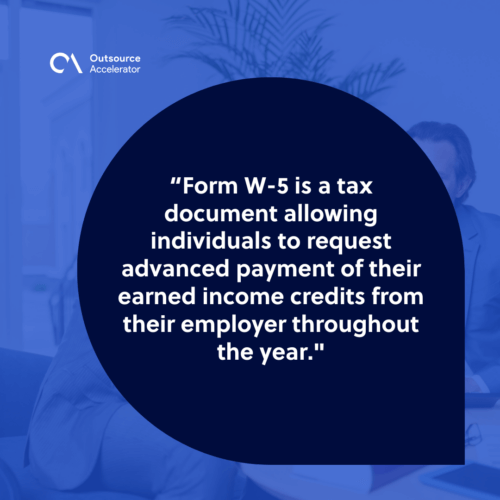A comprehensive guide to IRS Form W-5

The earned income credit is useful for requesting advance payments for tax credits.
The IRS Form W-5 was once used to help individuals collect this earned credit. While it has been discontinued, there are still ways they can earn credit by filing individual taxes.
This guide will delve into the details of Form W-5, its purpose, historical usage, reasons for discontinuation, and available alternative options.
What is IRS Form W-5?
See 2009 Form W-5, Publication 596, Earned Income Credit
Form W-5 was called the earned income credit advance payment certificate. It is a tax document allowing individuals to request advanced payment of their earned income credits from their employer throughout the year.
This form was created to assist individuals with low to moderate income by providing them with incremental payments when they file their annual tax returns.

Purpose of Form W-5
The primary purpose of Form W-5 is to provide eligible individuals with additional income during the year.
Earned income credits are refundable tax credits intended to benefit working individuals and families with low to moderate income. It is a good complement to in-kind benefits to help alleviate a staff’s daily needs.
Individuals can ease their financial burden and meet their ongoing commitments more effectively by requesting advance payments of their earned income credit.
What was Form W-5 used for?
In the past, Form W-5 was commonly used by eligible individuals to receive advance payments of their earned income credit.
Receiving these advance payments provided individuals with a valuable source of additional income throughout the year. People used this to cover expenses or invest in personal and professional development.
Why is Form W-5 no longer used?
In 2010, President Obama signed the Education Jobs and Medicare Assistance Act into law.
With this, the advance earned income credit and Form W-5 were revealed. This change was implemented to streamline the tax credit process, reduce potential errors or overpayments, and ensure fairness and accuracy in the tax system.
Can you still claim earned income credits?
Absolutely! Despite discontinuing advance payments through Form W-5, eligible individuals can still claim their earned income credits when they file their annual tax return.
The credits can help reduce their overall tax liability or even result in a refund, depending on their income, filing status, and the number of qualifying children they have.
Consult the official IRS guidelines and use tools such as the EITC Assistant to determine the amount of earned income credit you may be eligible for. These resources will provide accurate calculations based on your specific circumstances.

Alternatives to Form W-5
While advance payments through Form W-5 have been discontinued, eligible individuals can still claim their earned income credits through annual tax returns.
Remember, the tax landscape is subject to change, and staying informed with the latest IRS guidelines and seeking professional advice is vital to accurately navigating the tax system.
It’s important to note that consulting with tax professionals or utilizing official IRS resources is advisable when considering alternative options. They can provide personalized guidance based on your specific circumstances and ensure compliance with tax regulations.
Better yet, employers can help assist their teams by outsourcing tax accounting and providing the most accurate information.
Alternative options are available for individuals looking to maximize their tax credits. Here are a few worth considering:
Adjusting your tax withholding
One of the most common alternatives is adjusting your tax withholding on your Form W-4. By increasing the number of allowances you claim on your W-4, you can reduce the amount of taxes withheld from your paycheck.
This can effectively increase the money you receive in your paycheck throughout the year, providing you with more disposable income.
However, it’s essential to carefully review your tax situation and consult with a tax professional to avoid underpaying your taxes and incurring penalties.
Utilizing other tax credits
Form W-5 may have been specific to earned income credits, but several other tax credits can help reduce your overall tax liability.
For example, the Child Tax Credit provides a credit to eligible individuals for each qualifying child. The Child and Dependent Care Credit can assist with childcare and dependent care expenses.
Additionally, the American Opportunity Credit helps reduce the cost of education expenses. Exploring these alternative credits and determining eligibility can result in significant tax savings.

Planning for tax credits in your budgeting
Instead of relying on advance payments or adjusting your tax withholding, you can plan for the earned income credit or other tax credits in your budgeting.
By anticipating the amount of credits you expect to receive when filing your tax return, you can adjust your monthly budget accordingly.
This ensures that you are prepared for potential fluctuations in your income and helps you make the most of the credits when you receive them.







 Independent
Independent




